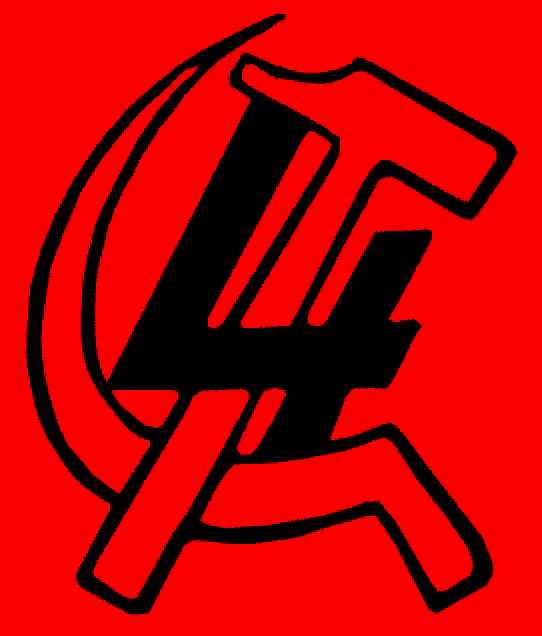
November 2006
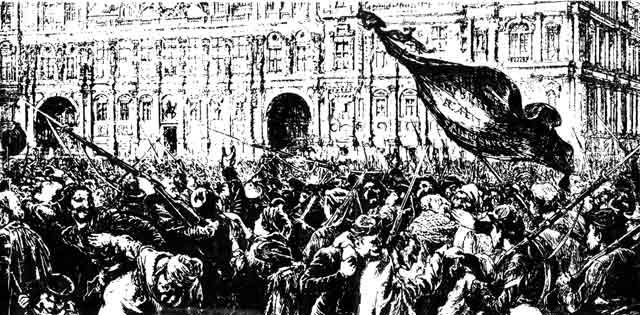
The Paris Commune, March-April 1871. (Engraving: Progress Publishers)
A
battle was won, but the war continues. And the outstanding fact about
the war
for Oaxaca is that, even though today it still takes the form and
raises
demands characteristic of a democratic struggle, underlying it
is the class
war. It all began with a teachers strike for rather modest demands
(above
all for rezonification1 for Oaxaca teachers). After June 14,
their main demand has been for the
expulsion of the murderous governor. In principle, none of this goes
beyond the
capitalist framework. Nevertheless, the struggle not only faces a
despotic cacique
(political boss), but the whole semi-bonapartist regime of the
Institutional
Revolutionary Party (PRI), which ruled Mexico uninterruptedly for 70
years and
is still intact in Oaxaca. The many thousands of political operatives
who ran
the single-party PRI-government in the state are still there, but now
deathly
afraid of losing their sinecures and facing the ire of an irate
populace.
In
reality, to bring down this regime and defeat its last-ditch defenders
will
take something approaching a political revolution. Moreover, the
struggle takes
place in a society characterized by a deep division between a narrow,
oligarchic
European-derived (criollo) ruling class, and a huge mass of
working
people largely of Indian origin. With this political and social
structure,
semicolonial in the strictest sense, “those at the bottom” cannot win
without
going outside the bourgeois-democratic framework and undertaking a
social revolution.
Replacing the governor to get another PRI politician, or even a
bourgeois
“independent,” in his place would not change much, with the possible
exception
of the level of repression – and maybe not even that. In order for
the
working people to win their struggle, the popular rebellion must turn
into
workers revolution.
Some
leftists are acting as if this has already happened. In recent weeks,
there has
been a spate of articles by “progressive” commentators in the bourgeois
press
and leftist groups referring to a “Oaxaca Commune.” This was the title
of an
article by Luis Hernández Navarro in La Jornada (25
July). Another by
the Agencia Latinoamericana de Información was titled, “The
Oaxaca Commune
Rises Up” (ALAI, 29 September). Iván Rincón Espríu
wrote about “Tlatelolco and
the Oaxaca Commune” in the Oaxacan daily Noticias (5 October).
“Mexico:
Long Live the Oaxaca Commune!” proclaimed the Trotskyist Faction (FT)
in a 6
September declaration, and more recently “Defend the Oaxaca Commune!”
The FT’s
Mexican group, the Liga de Trabajadores por el Socialismo (LTS –
Socialist
Workers League), refers to “The Oaxaca Commune on Alert” (La Verdad
Obrera,
5 October). “The Oaxaca Commune: APPO,” writes the Militante group (6
November). In Brazil on November 2 there were a number of “actions in
solidarity with the Oaxaca Commune.” On Radio APPO as well, announcers
often
say they are transmitting from the Oaxaca Commune, like Radio Habana
signs off
with the slogan “transmitting from the first free territory of America.”
Is
there a Oaxaca Commune? Let’s take a look at the key point of
reference: the
Paris Commune of 1871. Following the defeat of the army of emperor
Louis
Napoléon in the war against Germany and the proclamation of the
Republic in September
1870, the French capital continued to be besieged by the Germans. The
plebeian
population of Paris distrusted the bourgeois government, which was
enjoying the
pleasures of a golden refuge in the Versailles Palace. This government,
for its
part, feared the National Guard because of its proletarian composition.
When
the regime tried to dissolve the Guard on 18 March 1871, it rebelled
and the
Parisian workers suddenly found themselves in power.
The
image of a besieged revolutionary citadel is not totally alien in the
present
Oaxacan context, particularly today as it approaches a
near-insurrectionary
situation. At the same time, it is certainly not a very heartening
image, presaging
a bloody defeat. The Paris Commune was smashed after 72 days, with a
toll of
more than 30,000 dead and 50,000 jailed among the communards. This is
what Iván
Rincón Espríu was referring to in warning of the danger
of a repetition of the
1968 massacre in the Plaza de Tlatelolco, when the Mexican army
massacred
perhaps 500 students and leftists. “The troops who will try to smash
the Oaxaca
Commune and drown the popular discontent in blood and fire (in the
process
increasing it) have already located their attack points and have taken
up their
positions,” he wrote in early October.
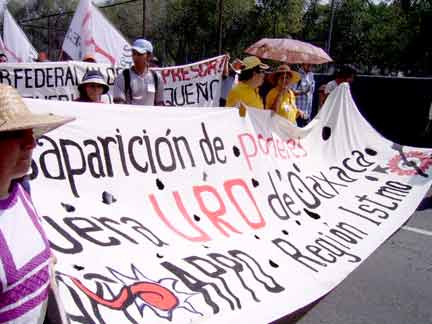 March of the APPO arrives in Mexico City on
9 October. Banner calls for ouster of Oaxaca governor Ulises Ruiz
Ortiz.
March of the APPO arrives in Mexico City on
9 October. Banner calls for ouster of Oaxaca governor Ulises Ruiz
Ortiz.
(Photo: El Internacionalista)
Hernández
Navarro’s starting point is also valid: he writes that the movement
begun by
the Oaxaca teachers strike is the kind of social struggle that presages
others
of greater magnitude, like the strikes in Cananea (miners) and
Río Blanco
(textile workers) that were precursors to the Mexican Revolution of
1910-17.
His conclusion, however, is to add the Oaxaca rebellion to the struggle
against
“the cochinero [roughly, swinishness] carried out in the July 2
elections” – i.e., the López Obrador mobilizations under the
mantle of the
bourgeois PRD.
In the case of protests against repression
that seek
to express enthusiastic support to the heroic Oaxacan fighters, the
reference
is understandable. But when tendencies which claim to be Marxist and
Trotskyist
refer to a “Oaxaca Commune,” above all when they do so as praise and
glorification,
this demonstrates a dangerous theoretical and programmatic
light-mindedness:
instead of clarifying, it obscure the necessary lessons and measures to
win the
battle of Oaxaca. It distorts reality by conferring on it a
revolutionary
content that has yet to be realized, and it reveals that the authors
live in a
fantasy world. Even worse, in losing confidence in the working class as
the
vanguard, they look for substitutes: they replace the class struggle
with a
“democratic,” or rather, “democratizing,” outlook. Instead of the
dictatorship
of the proletariat, they call for “organs of self-determination of the
masses”
(LTS, Estrategia Obrera, 21 October).
What
was the Paris Commune? Among “the multiplicity of interpretations to
which the
Commune has been subjected, and the multiplicity of interests which
construed
it in their favor,” Karl Marx wrote in The Civil War in France
(May
1871), “Its true secret was this: It was essentially a working class
government, the product of the struggle of the producing against the
appropriating class, the political form at last discovered under which
to work
out the economical emancipation of labor.” Later on in the same text he
calls
the Commune a “workers government.” Engels repeats, in his 1891
introduction to
Marx’s work, “Of late, the social-democratic philistine has once more
been
filled with wholesome terror at the words: Dictatorship of the
Proletariat.
Well and good, gentlemen, do you want to know what this dictatorship
looks
like? Look at the Paris Commune. That was the Dictatorship of the
Proletariat.”
Those
who today refer to a Oaxaca Commune as “real democracy” or the
“self-determination of the masses” without class distinction trace
their
lineage not to the great revolutionary theoreticians but to the great
granddaddy of the opportunists, the “social-democratic philistine” par
excellence,
Karl Kautsky, who in his anti-Soviet screed Terrorism and Communism
(1919) distorted Marx’s words in describing the Paris Commune as “the
government of the people by the people, that is, democracy.”
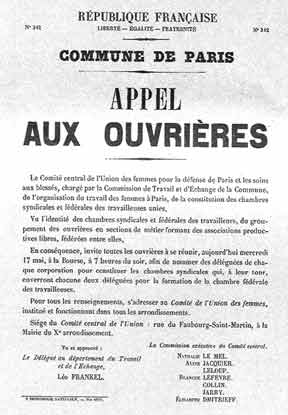 Appeal by the Paris
Commune calling for the election of delegates to a federal chamber of
women workers.
Appeal by the Paris
Commune calling for the election of delegates to a federal chamber of
women workers.
The
Paris Commune was a workers government, an incarnation of the
dictatorship of
the proletariat – two synonymous phrases – not because Marx and Engels
said so,
but because of its own self-conception, its composition and its
actions. The
proclamation of the Commune, the Declaration of the Central Committee
of the
National Guard of 18 March 1871, stated: “The proletarians of Paris,
amidst the
failures and treasons of the ruling classes, have understood that the
hour has
struck for them to save the situation by taking into their own hands
the
direction of public affairs.... They have understood that it is their
imperious
duty, and their absolute right, to render themselves masters of their
own
destinies, by seizing upon the governmental power.”
Marx
immediately added: “But the working class cannot simply lay hold of the
ready-made state machinery, and wield it for its own purposes.” The
proletariat
had to build its own government, in which “the majority of its members
were
naturally workers, or acknowledged representatives of the working
class. The
Commune was to be a working, not a parliamentary body, executive and
legislative
at the same time.” This was the main amendment Marx and Engels made to
the Communist
Manifesto since it was written in 1848.
So
let’s take a look at the Oaxacan situation today. The leading body of
the
struggle, the Popular Assembly of the Peoples of Oaxaca, does not
define itself
as a government, nor is it one in fact. It is an organ of struggle,
whose leadership
consists of representatives of different organizations. Until now, the
large
majority of the delegates have not been elected but rather were named
by the
leaderships of the groups which make up the APPO. Its backbone is
Section 22 of
the SNTE-CNTE (the teachers union), and it includes various unions of
public
employees (workers of the secretariat of health, the Social Security
Institute,
the ISSTE, the University of Oaxaca, airports) belonging to the FSODO
(Front of
Unions and Democratic Organizations of Oaxaca), as well as telephone
workers
and bus drivers, along with semi-labor groups (Associated Women Trade
Unionists,
retired railroad workers) and leftist organizations (Frente Popular
Revolucionario, Comité de Defensa de los Derechos del Pueblo
[Committee for
Defense of the Rights of the People], Partido Obrero Socialista
[Socialist
Workers Party, now rebaptized the Movement for Socialism]). But it also
includes
a number of organizations of indigenous peoples – the Organization of
Indigenous Zapotec Peoples (OPIZ), the Popular Indigenous Council of
Oaxaca
(CIPO), the Union of Indigenous Communities of the Northern Isthmus
(UCIZONI),
Movement of United Triqui Struggle (MULT) – and peasant organizations.
There
is no doubt that the APPO has struck root in the Oaxacan masses by
having
resisted for so long the siege by state and federal governments and the
murderous violence of the thugs and paramilitaries. But it is not a
nascent
workers government. The APPO has a multi-class character, with a
petty-bourgeois leadership in which popular-front politics predominate.
The
decisions of the National Forum on Constructing Democracy and
Governability
called by the APPO last August 16 and 17, for example, called to
“generate
alliances with different sectors and political actors premised on our
main
demand: for the ouster of Ulises Ruiz Ortiz.” At the same time, it
urged “the installation
of a Popular Government Council” and the formation of a “Great National
Popular
Assembly.” For many in the APPO, these calls are directed at the PRD,
whose
representatives have had discussions with the APPO in Oaxaca in recent
days.
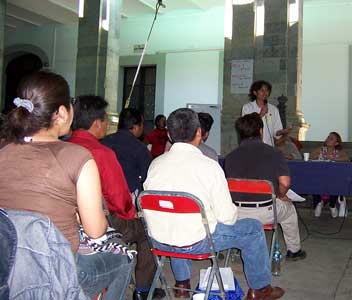 Spokesman of the Grupo
Internacionalista speaks to forum called by APPO in mid-August. PRD
supporters tried to shout him down.
Spokesman of the Grupo
Internacionalista speaks to forum called by APPO in mid-August. PRD
supporters tried to shout him down.
(Photo:
El Internacionalista)
To
be sure, the APPO and Section 22 have had to carry out certain
governmental functions,
constituting the Honorable Body of Topiles (a kind of popular
police,
derived from indigenous community organizations) and the Oaxaca
Teachers Police
(POMO) to maintain order in the occupied city, detaining thieves and in
some
cases submitting them to popular trials. But these are only episodic
organs and
measures of struggle of the sort that would arise in any general strike
that
lasted for a time.
It is also true that there are aspects of
dual power
with the occupation of the capital by the APPO and the installation of
popular
municipal councils in around 20 municipalities. But this is not dual
power of different
classes. The APPO has not made any moves against private property
whatsoever: it has not taken over hotels, or haciendas, factories or
transportation
companies. Nor has it seized federal government institutions, like the
highways
or airport. Above all, with its call for “peaceful” resistance against
the onslaught
by the forces of Ulises Ruiz and the federal government, it has not
called into
question the bourgeois state’s monopoly of armed force. In fact, in
negotiations with the interior ministry (Gobernación) APPO
leaders accepted in
principle the incursion of the Federal Preventive Police into Oaxaca.
In
December 1905, when Leon Trotsky was jailed as president of the
Petersburg
Soviet, he wrote a piece titled “35 Years Later: 1871-1906,” in which
he
stated:
“The Paris Commune of 1871 was not, of
course, a socialist
commune; its regime was not even a developed regime of socialist
revolution.
The ‘Commune’ was only a prologue. It established the dictatorship of
the
proletariat, the necessary premise of the socialist revolution. Paris
entered
into the regime of the dictatorship of the proletariat not because it
proclaimed the republic, but because out of 90 representatives it
elected 72 representatives
of the workers and stood under the protection of the proletarian guard.”
None of this exists in Oaxaca yet.
For now it
is Zukunftsmusik, “music of the future” to which we may aspire
and for
which communists struggle. But to confound our desires with actual
reality
would be fatal for the future development of revolutionary struggle in
Mexico.
There is not a proletarian power in Oaxaca, and for it to come into
being, the
struggle would have to be waged, not in the confines of a predominantly
peasant
and rural state bur instead by extending the insurgency to the big
battalions
of the working class in the capital of the country and the industrial
centers.
To achieve this, it is indispensable to forge a leadership, a party,
which
fights not for “real (bourgeois) democracy,” but openly for workers
revolution. n
See also:
To contact the Internationalist Group and the League for the Fourth International, send e-mail to: internationalistgroup@msn.com